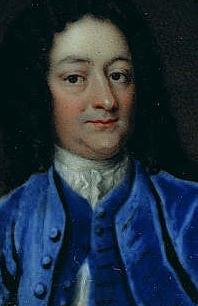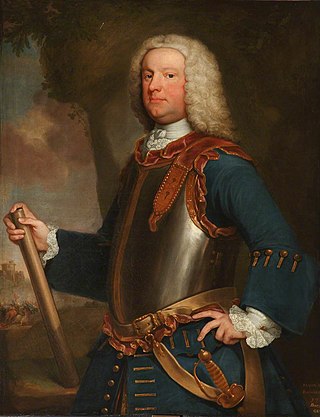
The Battle of Dettingen took place on 27 June 1743 during the War of the Austrian Succession at Dettingen in the Electorate of Mainz, Holy Roman Empire. It was fought between a Pragmatic Army, composed of the British, Hanoverian and Austrian troops, and a French army commanded by the duc de Noailles.

Prince William Augustus, Duke of Cumberland was the third and youngest son of King George II of Great Britain and Ireland and his wife, Caroline of Ansbach. He was Duke of Cumberland from 1726. He is best remembered for his role in putting down the Jacobite Rising at the Battle of Culloden in 1746, which made him immensely popular throughout parts of Britain. He is often referred to by the nickname given to him by his Tory opponents: 'Butcher' Cumberland.

The Battle of Fontenoy was a major engagement of the War of the Austrian Succession, fought on 11 May 1745 near Tournai in modern Belgium. A French army of 50,000 under Marshal Saxe defeated a Pragmatic Army of roughly the same size, led by the Duke of Cumberland.

John Forbes was a Scottish professional soldier who served in the British Army from 1729 until his death in 1759.

Field Marshal Studholme Hodgson was a British Army officer who served during the 18th century. After serving as an Aide-de-Camp to the Duke of Cumberland at the Battle of Fontenoy during the War of the Austrian Succession and at the Battle of Culloden during the Jacobite Rebellion, he became correspondent to William Barrington, the Secretary at War, during the French and Indian War. He went on to command the British expedition which captured Belle Île in June 1761 during the Seven Years' War so enabling the British Government to use the island as a bargaining piece during the negotiations leading up to the Treaty of Paris in 1763.

The Battle of Prestonpans, also known as the Battle of Gladsmuir, was fought on 21 September 1745, near Prestonpans, in East Lothian, the first significant engagement of the Jacobite rising of 1745.

Henry Hawley was a British army officer who served in the wars of the first half of the 18th century. He fought in a number of significant battles, including the Capture of Vigo in 1719, Dettingen, Fontenoy and Culloden.

The Battle of Rocoux took place on 11 October 1746 during the War of the Austrian Succession, at Rocourt, near Liège in the Prince-Bishopric of Liège, now modern Belgium. It was fought between a French army under Marshal Saxe and a combined British, Dutch, German and Austrian force led by Charles of Lorraine, John Ligonier and Prince Waldeck.

The Battle of Lauffeld, variously known as Lafelt, Laffeld, Lawfeld, Lawfeldt, Maastricht, or Val, took place on 2 July 1747, between Tongeren in modern Belgium, and the Dutch city of Maastricht. Part of the War of the Austrian Succession, a French army of 80,000 under Marshal Saxe defeated a Pragmatic Army of 120,000, led by the Duke of Cumberland.
Events from the year 1745 in Great Britain.

Lieutenant-General Richard Onslow was a British Army officer and politician. After the death of their parents, his older brother Arthur bought him a captain's commission in the British Army. He first saw action in the Anglo-Spanish War in 1727, after which he was returned to Parliament for the family borough of Guildford. His political contributions were negligible in comparison to his brother, and he continued to serve as a career officer, holding commands in the War of the Austrian Succession at Dettingen and Fontenoy. In 1759, he was appointed Governor of Plymouth and commander of the Western District, and died as a lieutenant-general the following year while presiding over two prominent courts-martial.

The siege of Bergen op Zoom took place during the Austrian War of Succession, when a French army, under the command of Count Löwendal and the overall direction of Marshal Maurice de Saxe, laid siege and captured the strategic Dutch border fortress of Bergen op Zoom on the border of Brabant and Zeeland in 1747. The fortress was defended by Dutch, Austrians, British, Hanoverians and Hessians that supported the Pragmatic Sanction.

Lieutenant General John Huske was a British military officer whose active service began in 1707 during the War of the Spanish Succession and ended in 1748.

The Fall of Ghent occurred on 15 July 1745 during the War of the Austrian Succession when a 5,000 strong French force under Ulrich Frédéric Woldemar, Comte de Lowendal surprised and captured the town of Ghent in the Austrian Netherlands. The Allied garrison offered little resistance.
The Battle of Melle was an encounter battle fought on 9 July 1745, during the War of the Austrian Succession, between forces of the Pragmatic Allies and the French. After their defeat at Fontenoy in May, the Duke of Cumberland, Allied commander in Flanders, was under pressure from the Austrians to defend Brussels. He also wanted to protect the key port of Ghent, a major supply depot threatened by the French advance into West Flanders.

The Battle of Fontenoy, 11 May 1745, was a major engagement of the War of the Austrian Succession, fought between the forces of the Pragmatic Army – comprising mainly Dutch, British, and Hanoverian troops, as well a relatively small contingent of Austrians under the command of the Duke of Cumberland – and a French army under the titular command of King Louis XV of France, with actual field command held by Maurice de Saxe, commander of Louis XV's forces in the Low Countries.

General William Belford was a British artillery officer who began his career in 1726. He was part of the first generation of artillery officers selected and promoted on merit, rather than connections.

James Cholmondeley was a British Army officer and Member of Parliament between 1731 and 1747.

Lieutenant-General Sir James Campbell, KB was a Scottish professional soldier, Member of Parliament for Ayrshire from 1727 to 1741, and Governor of Edinburgh Castle from 1738 to 1745.

The Pragmatic Army was an army which served during the War of the Austrian Succession. It was formed in 1743 by George II, who was both King of Great Britain and Elector of Hanover, and consisted of a mixture of British, Irish and German forces. It was designed to uphold the Pragmatic Sanction in support of George's ally Maria Theresa of Austria and took its name from this.


















